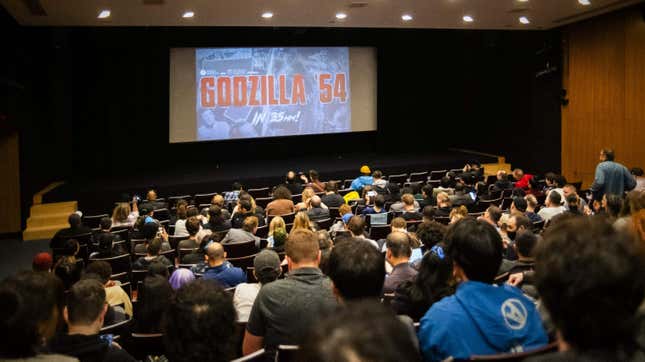
To commemorate Godzilla Minus One, the first Japanese film in the kaiju franchise since 2016 (out December 1 in the U.S.), the New York Japan Society screened a dusky archival print of the original 1954 movie Godzilla, which I had never seen before. Earlier this month, I came to the non-profit’s snug Midtown headquarters under the oily city sky—it had been raining so many weekends in a row—to see Godzilla on 35 millimeter. In time for its 69th anniversary on October 27, I realize that not enough has changed since its initial release.
We have iPhones now, fine. And, now, artificial intelligence can quickly assemble me an opulent self-portrait, though it would likely forget I have arms. But through war, protests, one global pandemic, and more sickening war, I always feel a storm cloud shudder over my head, telling me that humanity’s attitude has stubbornly stayed the same for as long as we could live.
I’m thinking about this while I watch Godzilla emerge from the water, which looks like runny mascara in this print. It rolls off the monster’s body like pearls of liquid mercury, or salty tears.
Read More: Games For Gaza Fundraising Bundle Surpasses $15M Goal In Hours
Godzilla is an unhappy product of war. He was a hardy prehistoric reptile until U.S. nuclear tests ruined the Pacific Ocean with unnatural waves of death, turning one of nature’s miracles into a colossus and a liability. He can’t speak, and he can’t die (easily). I watch Godzilla’s rough skin absorb rounds of bullets like copper soaks up lightning, and I feel sorry for him. He rips the tops off of homes in Tokyo to cope, turning the city into a “sea of flames,” a news broadcaster says, showing us how long war can continue, how unintended its consequences can be, how many children have to die before we decide, “Okay, I’ve had enough.”
In the 69 years since Godzilla’s release, audiences have latched onto its violence not as a flashing orange warning, but as a demonstration of how cool big monsters look on-screen. The franchise includes over 40 sequels and countless hissing action figures.
And I do like how large Godzilla’s footprints are, and seeing things explode. “But what about the horror that faces us now?” a Godzilla character asks to no reply.
I haven’t decided. But when I walk home under spired Midtown skyscrapers, which look like destruction at this time of night, I imagine Godzilla as my anti-war poster boy. We’ve ignored his haunted heartache for so long, choosing always to make money out of devastation instead of avoiding it. But I have to believe that, with time, truth becomes increasingly unavoidable: more bombs can only ever breed more monsters.




